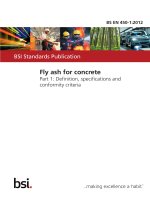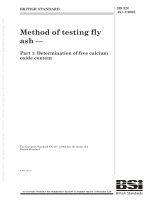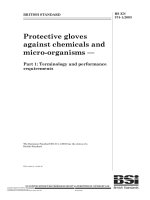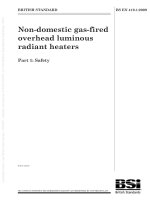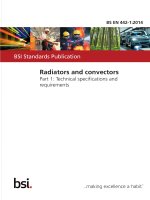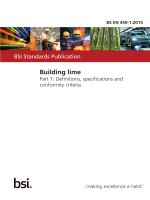Bsi bs en 00571 1 1997
Bạn đang xem bản rút gọn của tài liệu. Xem và tải ngay bản đầy đủ của tài liệu tại đây (151.08 KB, 17 trang )
British Standard
Licensed Copy: Tom Magee, Howden Power, 15 May 2003, Uncontrolled Copy, (c) BSI
A single copy of this British Standard is licensed to
Tom Magee
15 May 2003
This is an uncontrolled copy. Ensure use of the most
current version of this document by searching British
Standards Online at bsonline.techindex.co.uk
BRITISH STANDARD
Non-destructive testing Ð
Penetrant testing
Licensed Copy: Tom Magee, Howden Power, 15 May 2003, Uncontrolled Copy, (c) BSI
Part 1. General principles
The European Standard EN 571-1 : 1997 has the status of a
British Standard
ICS 19.100
NO COPYING WITHOUT BSI PERMISSION EXCEPT AS PERMITTED BY COPYRIGHT LAW
|
|
|
|
|
|
|
|
|
|
|
|
|
|
|
|
|
|
|
|
|
|
|
|
|
|
|
|
|
|
|
|
|
|
|
|
|
|
|
|
|
|
|
|
|
|
|
|
|
|
|
|
|
|
|
|
|
|
|
|
|
|
|
|
|
|
|
|
|
|
|
|
|
|
|
|
|
|
|
|
|
|
|
|
|
|
|
|
|
|
|
|
|
|
|
|
|
|
|
|
|
|
|
|
|
|
|
|
|
|
|
|
|
|
|
|
|
|
|
|
|
|
|
|
|
|
|
|
|
BS EN
571-1 : 1997
BS EN 571-1 : 1997
Committees responsible for this
British Standard
Licensed Copy: Tom Magee, Howden Power, 15 May 2003, Uncontrolled Copy, (c) BSI
The preparation of this British Standard was entrusted to Technical Committee
WEE/46, Non-destructive testing, upon which the following bodies were
represented:
Aluminium Federation
Associated Office Technical Committee
Association of Consulting Engineers
BNF (Fulmer Materials Centre)
British Airways
British Chemical Engineering Contractors' Association
British Coal Corporation
British Gas plc
British Institute of Non-destructive Testing
British Non-Ferrous Metals Association
British Nuclear Fuels plc
British Railways Board
British Steel Industry
Castings Technology International
Electricity Association
Engineering Equipment and Materials Users' Association
Health and Safety Executive
Institute of Physics
Institute of Quality Assurance
Light Metal Founders' Association
Lloyd's Register of Shipping
Ministry of Defence
National Radiological Protection Board
Power Generation Contractors' Association (PGCA) (BEAMA Ltd.)
Railway Industry Association of Great Britain
Royal Society of Chemistry
Society of British Aerospace Companies Limited
Society of Motor Manufacturers and Traders Limited
Welding Institute
This British Standard, having
been prepared under the
direction of the Engineering
Sector Board, was published
under the authority of the
Standards Board and comes into
effect on
15 June 1997
BSI 1997
Amendments issued since publication
Amd. No.
The following BSI references
relate to the work on this
standard:
Committee reference WEE/46
Draft for comment 91/82089 DC
ISBN 0 580 27603 1
Date
Text affected
BS EN 571-1 : 1997
Contents
Licensed Copy: Tom Magee, Howden Power, 15 May 2003, Uncontrolled Copy, (c) BSI
Committees responsible
National foreword
Foreword
Text of EN 571-1
BSI 1997
Page
Inside front cover
ii
2
3
i
BS EN 571-1 : 1997
National foreword
This Part of BS EN 571 has been prepared by Technical Committee WEE/46 and is the
English language version of EN 571-1 Non-destructive testing Ð Penetrant testing Ð
Part 1: General principles, published by the European Committee for Standardization
(CEN). EN 571-1 was produced as a result of international discussion in which the UK
took an active part.
BS EN 571-1 supersedes BS 6443 : 1984 which is withdrawn.
Cross-references
Publication referred to
Corresponding British Standard
EN 473 : 1993
BS EN 473 : 1993 Qualification and certification of NDT
personnel Ð General principles
Licensed Copy: Tom Magee, Howden Power, 15 May 2003, Uncontrolled Copy, (c) BSI
Compliance with a British Standard does not of itself confer immunity
from legal obligations.
Summary of pages
This document comprises a front cover, an inside front cover, pages i and ii, the
EN title page, pages 2 to 10, an inside back cover and a back cover.
ii
BSI 1997
EN 571-1
EUROPEAN STANDARD
NORME EUROPÊENNE
EUROPẰISCHE NORM
January 1997
ICS 19.100
Descriptors: Non-destructive tests, liquid penetrant tests, inspection methods, safety measures, procedure, characteristics, classification s,
designation, macroscopic analysis
English version
Non-destructive testing Ð Penetrant testing Ð
Part 1: General principles
Licensed Copy: Tom Magee, Howden Power, 15 May 2003, Uncontrolled Copy, (c) BSI
Essais non destructifs Ð Examen par ressuage Ð
Partie 1: Principes geÂneÂraux
ZerstoÈrungsfreie PruÈfung Ð EindringpruÈfung Ð
Teil 1: Allgemeine Grundlagen
This European Standard was approved by CEN on 1995-01-14. CEN members are
bound to comply with the CEN/CENELEC Internal Regulations which stipulate the
conditions for giving this European Standard the status of a national standard
without any alteration.
Up-to-date lists and bibliographical references concerning such national standards
may be obtained on application to the Central Secretariat or to any CEN member.
This European Standard exists in three official versions (English, French, German).
A version in any other language made by translation under the responsibility of a
CEN member into its own language and notified to the Central Secretariat has the
same status as the official versions.
CEN members are the national standards bodies of Austria, Belgium, Denmark,
Finland, France, Germany, Greece, Iceland, Ireland, Italy Luxembourg, Netherlands,
Norway, Portugal, Spain, Sweden, Switzerland and United Kingdom.
CEN
European Committee for Standardization
Comite EuropeÂen de Normalisation
EuropaÈisches Komitee fuÈr Normung
Central Secretariat: rue de Stassart 36, B-1050 Brussels
1997 Copyright reserved to CEN members
Ref. No. EN 571-1 : 1997 E
Page 2
EN 571-1 : 1997
Foreword
Contents
This European Standard has been prepared by
Technical Committee CEN/TC 138, Non-destructive
testing, the secretariat of which is held by AFNOR.
This European Standard shall be given the status of a
national standard, either by publication of an identical
text or by endorsement, at the latest by July 1997, and
conflicting national standards shall be withdrawn at
the latest by July 1997.
In the framework of its scope, Technical Committee
CEN/TC 138 entrusted CEN/TC 138/WG 4, Liquid
penetrant testing, to prepare this European Standard.
EN 571 comprises a series of European Standards on
penetrant testing which is made of the following:
Licensed Copy: Tom Magee, Howden Power, 15 May 2003, Uncontrolled Copy, (c) BSI
EN 571-1
EN 571-2
EN 571-3
Non-destructive testing Ð Penetrant
testing Ð
Part 1: General principles
Non-destructive testing Ð Penetrant
testing Ð
Part 2: Testing of penetrant materials
Non-destructive testing Ð Penetrant
testing Ð
Part 3: Reference test blocks
Foreword
1
Scope
2
Normative references
3
Definitions
4
Safety precautions
5
General principles
6
Products, sensitivity and designation
7
Compatibility of testing materials with
the part(s) to be tested
8
Test procedure
9
Test report
Annexes
A
(normative) Main stages of the
penetrant examination
B
(informative) Example of a test report
Page
2
3
3
3
3
3
4
5
5
8
9
10
This European Standard has been prepared under a
mandate given to CEN by the European Commission
and the European Free Trade Association, and
supports essential requirements of EU Directive(s).
According to the CEN/CENELEC Internal Regulations,
the national standards organizations of the following
countries are bound to implement this European
Standard: Austria, Belgium, Denmark, Finland, France,
Germany, Greece, Iceland, Ireland, Italy, Luxembourg,
Netherlands, Norway, Portugal, Spain, Sweden,
Switzerland and the United Kingdom.
BSI 1997
Licensed Copy: Tom Magee, Howden Power, 15 May 2003, Uncontrolled Copy, (c) BSI
Page 3
EN 571-1 : 1997
1 Scope
3 Definitions
This standard defines a method of penetrant testing
used to detect discontinuities, e.g. cracks, laps, folds,
porosity and lack of fusion, which are open to the
surface of the material to be tested. It is mainly applied
to metallic materials, but can also be performed on
other materials, provided that they are inert to the test
media and they are not excessively porous, examples
of which are castings, forgings, welds, ceramics, etc.
This standard is not intended to be used for
acceptance criteria and gives no information relating to
the suitability of individual test systems for specific
applications nor requirements for test equipment.
The term `discontinuity' is used here in the sense that
no evaluation concerning acceptability or
non-acceptability is included.
Methods for determining and monitoring the essential
properties of penetrant testing products to be used are
specified in EN 571-2 and EN 571-3.
For the purposes of this standard the definitions of
prEN 1330-6 apply.
2 Normative references
This European Standard incorporates by dated or
undated reference, provisions from other publications.
These normative references are cited at the
appropriate places in the text and the publications are
listed hereafter. For dated references, subsequent
amendments to or revisions of any of these
publications apply to this European Standard only
when incorporated in it by amendment or revision. For
undated references the latest edition of the publication
referred to applies.
EN 473
prEN 571-2
prEN 571-3
prEN 956
prEN 1330-6
prEN1956
1) In preparation.
BSI 1997
Qualification and certification of NDT
personnel Ð General principles
Non-destructive testing Ð Penetrant
testing Ð
Part 2: Testing of penetrant materials1)
Non-destructive testing Ð Penetrant
testing Ð
Part 3: Reference test blocks1)
Non-destructive testing Ð Penetrant
testing Ð Equipment
Non-destructive testing Ð
Terminology Ð
Part 6: Terms used in penetrant
systems 1)
Non-destructive testing Ð Penetrant
testing and magnetic particle testing Ð
Viewing conditions1)
4 Safety precautions
As penetrant inspection techniques often require the
use of harmful, flammable and/or volatile materials,
certain precautions shall be taken.
Prolonged or repeated contact of these materials with
the skin or any mucous membrane should be avoided.
Working areas shall be adequately ventilated and sited
away from sources of heat, sparks and naked flames in
accordance with local regulations.
The penetrant testing products and equipment shall be
used with care and always in compliance with the
instructions supplied by the manufacturer.
When using UV-A sources, care shall be taken to
ensure that unfiltered radiation from the UV-A source
does not directly reach the eyes of the operators.
Whether it forms an integral part of the lamp or is a
separate component, the UV-A filter shall always be
maintained in good condition.
There is legislation and regulations regarding health,
safety, pollution and storage, etc.
5 General principles
5.1 Personnel
The examination shall be carried out or supervised by
competent personnel and, if required, qualified and
certified according to EN 473 or to a system agreed
upon by the contracting parties.
5.2 Description of the method
Prior to penetrant testing the surface to be inspected
shall be cleaned and dried. Then suitable penetrants
are applied to the test area and enter into
discontinuities open to the surface. After the
appropriate penetration time has elapsed the excess
penetrant is removed from the surface and the
developer applied. This absorbs the penetrant that has
entered and remains in the discontinuities and may
give a clearly visible enhanced indication of the
discontinuity.
Should complementary non-destructive testing be
required, the penetrant inspection shall be performed
first unless agreed upon between the contracting
parties so as not to introduce contaminants into open
discontinuities. If penetrant inspection is used
following another non-destructive testing technique, the
surface shall be cleaned carefully to remove
contaminants before application.
Page 4
EN 571-1 : 1997
Table 1. Testing products
Penetrant
Excess penetrant remover
Developer
Type
Designation
Method Designation
Form
Designation
I
Fluorescent penetrant
a
Dry
b
Water soluble
c
Water suspendable
d
Solvent-based (non-aqueous
wet)
e
Water or solvent based for
special application
(e.g. peelable developer)
II
Colour contrast penetrant
III
Dual purpose (fluorescent
colour contrast penetrant)
A
Water
B
Lipophilic emulsifier
1 Oil-based emulsifier
2 Rinsing with running
water
C
Solvent (liquid)
D
Hydrophilic emulsifier
1 Optional prerinse (water)
2 Emulsifier (water-diluted)
3 Final rinse (water)
E
Water and solvent
Licensed Copy: Tom Magee, Howden Power, 15 May 2003, Uncontrolled Copy, (c) BSI
NOTE. For specific cases, it is necessary to use penetrant testing products complying with particular requirements with regards to
flammability, sulfur, halogen and sodium content and other contaminants, see prEN 571-2.
5.3 Process sequence
The sequence of operations is illustrated for the
general case in annex A.
Testing generally proceeds through the following
stages:
a) preparation and precleaning (see 8.2);
b) application of penetrant (see 8.3);
c) excess penetrant removal (see 8.4);
d) application of developer (see 8.5);
e) inspection (see 8.6);
f) recording (see 8.7);
g) postcleaning (see 8.8).
5.4 Equipment
The equipment for carrying out penetrant testing
depends on the number, size and shape of the parts to
be tested. For the requirements of equipment,
see EN 956.
5.5 Effectiveness
The effectiveness of the penetrant testing depends
upon many factors such as:
a) types of penetrant materials and testing
equipment;
b) surface preparation and condition;
c) material under examination and expected
discontinuities;
d) temperature of the test surface;
e) penetration and development time;
f) viewing conditions, etc.
6 Products, sensitivity and designation
6.1 Product family
Various test systems exist in penetrant testing.
A product family is understood as a combination of the
following penetrant testing materials: penetrant, excess
penetrant remover and developer. When tested in
accordance with prEN 571-2 the penetrant and excess
penetrant remover shall be from one manufacturer.
Only approved product families shall be used.
6.2 Testing products
The testing products are given in table 1.
6.3 Sensitivity
The sensitivity level of a product family shall be
determined using reference block 1 as described in
prEN 5713. The assessed level always refers to the
method used for type testing of the approved product
family.
6.4 Designation
The approved product family to be used for penetrant
testing is given a designation comprising the type, the
method and the form for the testing products, and a
figure which indicates the sensitivity level achieved by
testing with the reference block 1 as described in
prEN 571-3.
Example
Designation of an approved product family comprising
fluorescent penetrant (I), water as excess penetrant
remover (A) and a dry powder developer (a), and a
system sensitivity of level 2 is the following penetrant
testing system when using prEN 571-1 and
prEN 572-2 giving the example: product family
EN 571-IAa-2.
BSI 1997
Page 5
EN 571-1 : 1997
7 Compatibility of testing materials with
the part(s) to be tested
7.1 General
The penetrant testing products shall be compatible
with the material to be tested and the use for which
the part is designed.
7.2 Compatibility of penetrant testing products
The penetrant testing materials shall be compatible
with each other.
Penetrant materials from different manufacturers shall
not be mixed during the initial filling of the facility.
Dragout losses shall not be replaced using penetrant
materials from different manufacturers.
7.3 Compatibility of penetrant testing materials
with parts under examination
Licensed Copy: Tom Magee, Howden Power, 15 May 2003, Uncontrolled Copy, (c) BSI
7.3.1 In most cases the compatibility of products can
be assessed prior to use by means of the corrosion test
detailed in prEN 571-2.
7.3.2 The chemical or physical properties of some
non-metallics can be adversely affected by penetrant
testing materials; their compatibility has to be
established before inspecting parts manufactured from,
and assemblies that include, such materials.
7.3.3 In situations where contamination might occur,
it is essential to ensure that the penetrant testing
materials do not have a deleterious effect on fuels,
lubricants, hydraulic fluids, etc.
7.3.4 For parts associated with peroxide rocket fuel,
explosive stores (these include all items containing
explosive propellant, initiating or pyrotechnic
materials), oxygen equipment or nuclear applications
the compatibility of penetrant testing materials shall
require special consideration.
7.3.5 If, after postcleaning, penetrant testing materials
remain on the parts there is a possibility of corrosion,
e.g. of stress corrosion or of corrosion fatigue.
8 Test procedure
8.1 Written test procedure
When contractually required a written test procedure
shall be prepared and approved prior to the
examination.
8.2 Preparation and precleaning
Contaminants, e.g. scale, rust, oil, grease or paint shall
be removed, if necessary using mechanical or chemical
methods or a combination of these methods.
Precleaning shall ensure that the test surface is free
from residues and that it allows the penetrant to enter
any discontinuity. The cleaned area shall be large
enough to prevent interference from areas adjacent to
the actual test surface.
BSI 1997
8.2.1 Mechanical precleaning
Scale, slag, rust, etc., shall be removed using suitable
methods such as brushing, rubbing, abrasion, blasting,
high pressure water blasting, etc. These methods
remove contaminants from the surface and generally
are incapable of removing contaminants from within
surface discontinuities. In all cases and in particular in
the case of shot blasting, care shall be taken to ensure
that the discontinuities are not masked by plastic
deformation or clogging from abrasive materials. If
necessary, to ensure that discontinuities are open to
the surface subsequent etching treatment shall be
carried out, followed by adequate rinsing and drying.
8.2.2 Chemical precleaning
Chemical precleaning shall be carried out using
suitable chemical cleaning agents, to remove residues
such as grease, oil, paint or etching materials.
Residues from chemical precleaning processes can
react with penetrant and greatly reduce its sensitivity.
Acids and chromates in particular can greatly reduce
the fluorescence of fluorescent penetrants and the
colour of the colour contrast penetrant. Therefore,
chemical agents shall be removed from the surface
under examination, after the cleaning process, using
suitable cleaning methods which may include water
rinsing.
8.2.3 Drying
As the final stage of precleaning, the parts to be tested
shall be thoroughly dried, so that neither water nor
solvent remains in the discontinuities.
8.3 Application of penetrant
8.3.1 Methods of application
The penetrant can be applied to the part to be tested
by spraying, brushing, flooding, dipping or immersion.
Care shall be taken to ensure that the test surface
remains completely wetted throughout the entire
penetration time.
8.3.2 Temperature
In order to minimize moisture entering discontinuities,
the temperature of the test surface shall generally be
within the range from 10 ÊC to 50 ÊC. In special cases
temperatures as low as 5 ÊC may be used.
For temperatures below 10 ÊC or above 50 ÊC only
penetrant product families and procedures approved in
accordance with prEN 571-2 for this purpose shall be
used.
NOTE. Especially in the low temperature range there is a danger
of water condensing in the discontinuities and on the surfaces,
and this water will prevent the penetrant from entering the
discontinuities.
Page 6
EN 571-1 : 1997
8.3.3 Penetration time
The appropriate penetration time depends on the
properties of the penetrant, the application
temperature, the material of the part to be tested and
the discontinuities to be detected.
The penetration time can vary from 5 min to 60 min.
The penetration time should be at least as long as the
time used for the determination of sensitivity (see 6.3).
If not, the actual penetration time shall be recorded in
the written test procedure. In no case shall the
penetrant be allowed to dry during the penetration
time.
8.4 Excess penetrant removal
Licensed Copy: Tom Magee, Howden Power, 15 May 2003, Uncontrolled Copy, (c) BSI
8.4.1 General
The application of the remover medium shall be such
that no penetrant is removed from the discontinuities.
8.4.2 Water
The excess penetrant shall be removed using a suitable
rinsing technique. Examples: spray rinsing or wiping
with a damp cloth. Care shall be taken to minimize the
effect of mechanical action caused by the rinsing
method. The temperature of the water shall not
exceed 50 ÊC.
8.4.3 Solvents
Generally, the excess penetrant shall be removed first
by using a clean lint-free cloth. Subsequent cleaning
with a clean lint-free cloth lightly moistened with
solvent shall then be carried out. Any other removal
technique shall be approved by the contracting parties,
particularly when solvent remover is sprayed directly
on to the part to be tested.
8.4.4 Emulsifier
8.4.4.1 Hydrophilic (water-dilutable)
To allow the post-emulsifiable penetrant to be removed
from the test surface, it shall be rendered
water-rinsable by application of an emulsifier. Before
the application of the emulsifier, a water wash should
be performed in order to remove the bulk of the
excess penetrant from the test surface and to facilitate
a uniform action of the hydrophilic emulsifier which
will be applied subsequently.
The emulsifier shall be applied by immersion or by
foam equipment. The concentration and the contact
time of the emulsifier shall be evaluated by the user
through pre-tests according to the manufacturer's
instructions. The predetermined emulsifier contact time
shall not be exceeded. After emulsification, a final
wash shall be carried out as described in 8.4.2.
8.4.4.2 Lipophilic (oil-based)
To allow the post emulsifiable penetrant to be removed
from the test surface, it shall be rendered
water-rinsable by application of an emulsifier. This can
only be done by immersion. The emulsifier contact
time shall be evaluated by the user through pre-tests
according to the manufacturer's instructions.
This time shall be sufficient to allow only the excess
penetrant to be removed from the test surface during
the subsequent water wash. The emulsifying time shall
not be exceeded. Immediately after emulsification, a
water wash shall be carried out as described in 8.4.2.
8.4.5 Water and solvent
First the excess water-washable penetrant shall be
removed with water (see 8.4.2). Subsequent cleaning
with a clean lint-free cloth, lightly moistened with
solvent, shall be then carried out.
8.4.6 Excess penetrant removal check
During excess penetrant removal the test surface shall
be visually checked for penetrant residues. For
fluorescent penetrants, this shall be carried out under a
UV-A source. The minimum UV-A irradiance at the test
surface shall not be less than 3 W/m2 (300 mW/cm2).
When faced with excessive background on parts after
excess penetrant removal has been carried out, the
decision on future action shall be taken by a suitably
qualified person.
8.4.7 Drying
In order to facilitate rapid drying of excess water, any
droplets and puddles of water shall be removed from
the part.
Except when using water-based developer the test
surface shall be dried as quickly as possible after
excess penetrant removal, using one of the following
methods:
a) wiping with a clean, dry, lint-free cloth;
b) evaporation at ambient temperature after hot
water dip;
c) evaporation at elevated temperature;
d) forced air circulation;
e) a combination of the methods listed under a)
to d).
If compressed air is used, particular care shall be taken
to ensure that it is water- and oil-free and impinging
pressure on the surface of the part is kept as low as
possible.
The method of drying the part to be tested shall be
carried out in a way ensuring that the penetrant
entrapped in the discontinuities does not dry.
The surface temperature shall not exceed 50 ÊC during
drying unless otherwise approved.
8.5 Application of developer
8.5.1 General
The developer shall be maintained in a uniform
condition during use and shall be evenly applied to the
test surface.
The application of the developer shall be carried out as
soon as possible after the removal of excess penetrant.
BSI 1997
Page 7
EN 571-1 : 1997
8.5.2 Dry powder
Dry powder may only be used with fluorescent
penetrants. The developer shall be uniformly applied to
the test surface by one of the following techniques:
dust storm, electrostatic spraying, flock gun, fluidized
bed or storm cabinet. The test surface shall be thinly
covered; local agglomerations are not permitted.
Licensed Copy: Tom Magee, Howden Power, 15 May 2003, Uncontrolled Copy, (c) BSI
8.5.3 Water-suspendable developer
A thin uniform application of the developer shall be
carried out by immersion in agitated suspension or by
spraying with suitable equipment in accordance with
the approved procedure. Immersion time and
temperature of the developer shall be evaluated by the
user through pre-tests according to the manufacturer's
instructions. The immersion time shall be as short as
possible to ensure optimum results.
The part shall be dried by evaporation and/or by the
use of a forced air circulation oven.
8.5.4 Solvent-based developer
The developer shall be applied by spraying uniformly.
The spray shall be such that the developer arrives
slightly wet on the surface, giving a thin, uniform layer.
8.5.5 Water soluble developer
A thin uniform application of the developer shall be
carried out by immersion or by spraying with suitable
equipment in accordance with the approved procedure.
Immersion time and temperature of the developer shall
be evaluated by the user through pretests according to
the manufacturer's instruction. The immersion time
should be as short as possible to ensure an optimum
result.
The part shall be dried by evaporation and/or by the
use of a forced air circulation oven.
8.5.6 Water or solvent based for special
application (e.g. peelable developer)
When an indication that needs to be recorded is shown
with the penetrant inspection process the following
procedure should be used.
± Wipe off developer with a clean, dry, lint-free cloth.
± Apply the same penetrant by any convenient
means, then follow exactly the same process as
initially used, up to application of the developer.
± After excess penetrant removal and drying of the
part, apply the peelable developer as recommended
by the manufacturer.
± When the recommended development time has
elapsed, carefully peel off the developer coating.
Indication(s) appear(s) on the face of the coating
which was in direct contact with the part.
BSI 1997
8.5.7 Development time
The development time should be between 10 min
and 30 min; longer times may be agreed between the
contracting parties.
The development time begins
± immediately after application when dry developer
is applied;
± immediately after drying when wet developer is
applied.
8.6 Inspection
8.6.1 General
Generally, it is advisable to carry out the first
examination just after the application of the developer
or as soon as the developer is dry. This facilitates a
better interpretation of indications.
The final inspection shall be carried out when the
development time has elapsed.
Aids for visual examination, such as magnification
instruments or contrast spectacles, can be used.
NOTE. The diameter, width or intensity of the indication provide
limited information.
8.6.2 Viewing conditions
8.6.2.1 Fluorescent penetrants
Photochromatic spectacles shall not be worn.
Sufficient time shall be allowed for the operator's eyes
to become dark-adapted in the inspection booth,
usually at least 5 min.
UV radiation shall not be directed in the operator's
eyes. All surfaces which can be viewed by the
operators shall not fluoresce.
No paper or cloth which fluoresces under UV light
shall be in sight of the operator.
A UV-A background lighting may be provided, if
necessary, to allow the operator to move freely inside
the booth.
The test surface shall be viewed under a UV-A
radiation source, in accordance with prEN 1956. The
UV-A irradiance at the surface inspected shall not be
less than 10 W/m2 (1000 mW/cm2).
The statements above shall apply to inspections in
darkened rooms where the visible light is limited to a
maximum of 20 lx.
8.6.2.2 Colour contrast penetrants
The test surface shall be inspected under daylight or
under artificial white light with an illuminance of not
less than 500 lx on the surface of the tested part. The
viewing conditions shall be such that glare and
reflections are avoided.
Page 8
EN 571-1 : 1997
8.7 Recording
Recording may be done by any of the following
methods:
a) written description;
b) sketch;
c) adhesive tape;
d) peelable developer;
e) photograph;
f) photocopy;
g) video.
8.8 Postcleaning and protection
Licensed Copy: Tom Magee, Howden Power, 15 May 2003, Uncontrolled Copy, (c) BSI
8.8.1 Postcleaning
After final inspection, postcleaning of the part is
necessary only in those cases where the penetrant
testing products could interfere with subsequent
processing or service requirements.
8.8.2 Protection
If required a suitable corrosion protection shall be
applied.
8.9 Retesting
If retesting is necessary, e.g. because no unambiguous
evaluation of indications is possible, the entire test
procedure, starting with the precleaning, shall be
repeated.
If necessary, more favourable test conditions shall be
chosen for this procedure. The use of a different type
of penetrant or a penetrant of the same type from a
different supplier is not allowed unless a thorough
cleaning has been carried out to remove penetrant
residues remaining in the discontinuities.
9 Test report
The test report shall contain the following information
with reference to this standard:
a) information on the part tested
± designation
± dimensions
± material
± surface condition
± production stage;
b) purpose of testing;
c) designation of the penetrant system used, as
specified in 6.4, giving the manufacturer's name and
product designation as well as the batch number;
d) test instructions;
e) deviations from the test instructions;
f) test results (description of discontinuities
detected);
g) test location, date of testing, name of the
operator;
h) name, certification and signature of the test
supervisor.
The layout of a form that can be used for the test
report is given in annex B. It shall include all the
details relating to the method which are important for
the evaluation of the test results, and additional
information relating to the parts to be tested, although
this data should be modified, as appropriate,
depending on the type of part. If another form is used
it shall contain all the information detailed in items a)
to h).
The test report may be omitted if a test procedure
fulfilling the requirements of 8.1 is submitted,
containing the information mentioned in clause 9 from
a) to d) and if the information under e) to h) is
documented in an appropriate manner.
BSI 1997
Page 9
EN 571-1 : 1997
Annex A (normative)
Main stages of the penetrant examination
Preparation and precleaning
Dry
Apply waterwashable penetrant and allow
contact time
Water and solvent
Apply post-emulsifiable penetrant and allow
contact time
Apply solvent
remover
Water wash
Apply lipophilic
emulsifier and
allow contact
time
Water spray
rinse
Licensed Copy: Tom Magee, Howden Power, 15 May 2003, Uncontrolled Copy, (c) BSI
Apply solvent
removable penetrant and allow
contact time
Wipe clean
Apply hyrophilic
emulsifier and
allow contact
time
Allow to dry
Water wash
Water wash
Excess penetrant
remover check
Dry
Dry
Apply dry
developer
Apply water
soluble
developer
Apply water
suspendable
developer
Dry
Allow to dry
Development time
Inspect
Clean
Protect if
required
BSI 1997
Page 10
EN 571-1 : 1997
Annex B (informative)
Example of a test report
Test report
Company name:
Reference no.:
Departments:
Subreference no.:
Penetrant Testing
Test report no.: ±±±±±±±±
Parts:
Project:
Sheet ±±±±±±±±
of ±±±±±±±± sheets
Commissioned by:
Manufacturing no.:
Commission order no.:
Drawing no.:
Part to be tested:
further details, e.g.:
Weld plan no.:
Test follow-up plan no.:
Dimensions:
Weld no.:
Sheet no.:
Material:
Unit no.:
Part no.:
Cast no.:
Model no.:
Licensed Copy: Tom Magee, Howden Power, 15 May 2003, Uncontrolled Copy, (c) BSI
Surface condition:
Heat treatment condition:
Pretreatment:
Test instruction:
(e.g. specification, test direction, delivery condition)
Scope of testing:
Penetrant system
Designation:
(further details, e.g. free from corrosive constituents, in accordance with
prEN 571-2)
Manufacturer:
Product designation
Penetrant:
Batch no.:
Excess penetrant remover:
Batch no.:
Developer:
Batch no.:
Procedure
Test temperature:
Excess penetrant removal (further details, e.g. anticorrosive agents):
Precleaning:
Emulsifying time:
Drying:
Drying:
Penetration time:
Development time:
Postcleaning:
Deviations from the test instructions:
Deviations from EN 571-1:
Test results:
(e.g. for discontinuities: details of location, types, distributions, sizes and
number; sketch)
Test location:
Test date:
Evaluation
(in accordance with test instructions):
Remarks:
acceptable:
Test supervisor:
Certification:
Operator's name:
unacceptable:
Date:
Signature:
Date:
Signature:
Date:
Signature:
or
Commissioner/expert:
or
Test house:
BSI 1997
Licensed Copy: Tom Magee, Howden Power, 15 May 2003, Uncontrolled Copy, (c) BSI
BS EN 571-1 : 1997
List of references
See national foreword.
BSI 1997
Licensed Copy: Tom Magee, Howden Power, 15 May 2003, Uncontrolled Copy, (c) BSI
BSI
389 Chiswick High Road
London
W4 4AL
|
|
|
|
|
|
|
|
|
|
|
|
|
|
|
|
|
|
|
|
|
|
|
|
|
|
|
|
|
|
|
|
|
|
|
|
|
|
|
|
|
|
|
|
|
|
|
|
|
|
|
|
|
|
|
|
|
|
|
|
|
|
|
|
|
|
|
|
|
|
|
|
|
|
|
|
|
|
|
|
|
|
|
|
|
|
|
|
|
|
|
|
|
|
|
|
|
|
|
|
|
|
|
|
|
|
|
|
|
|
|
|
|
|
|
|
|
|
|
|
|
|
|
|
|
|
|
BSI Ð British Standards Institution
BSI is the independent national body responsible for preparing British Standards. It
presents the UK view on standards in Europe and at the international level. It is
incorporated by Royal Charter.
Revisions
British Standards are updated by amendment or revision. Users of British Standards
should make sure that they possess the latest amendments or editions.
It is the constant aim of BSI to improve the quality of our products and services. We
would be grateful if anyone finding an inaccuracy or ambiguity while using this
British Standard would inform the Secretary of the technical committee responsible,
the identity of which can be found on the inside front cover. Tel: 020 8996 9000.
Fax: 020 8996 7400.
BSI offers members an individual updating service called PLUS which ensures that
subscribers automatically receive the latest editions of standards.
Buying standards
Orders for all BSI, international and foreign standards publications should be
addressed to Customer Services. Tel: 020 8996 9001. Fax: 020 8996 7001.
In response to orders for international standards, it is BSI policy to supply the BSI
implementation of those that have been published as British Standards, unless
otherwise requested.
Information on standards
BSI provides a wide range of information on national, European and international
standards through its Library and its Technical Help to Exporters Service. Various
BSI electronic information services are also available which give details on all its
products and services. Contact the Information Centre. Tel: 020 8996 7111.
Fax: 020 8996 7048.
Subscribing members of BSI are kept up to date with standards developments and
receive substantial discounts on the purchase price of standards. For details of
these and other benefits contact Membership Administration. Tel: 020 8996 7002.
Fax: 020 8996 7001.
Copyright
Copyright subsists in all BSI publications. BSI also holds the copyright, in the UK, of
the publications of the international standardization bodies. Except as permitted
under the Copyright, Designs and Patents Act 1988 no extract may be reproduced,
stored in a retrieval system or transmitted in any form or by any means ± electronic,
photocopying, recording or otherwise ± without prior written permission from BSI.
This does not preclude the free use, in the course of implementing the standard, of
necessary details such as symbols, and size, type or grade designations. If these
details are to be used for any other purpose than implementation then the prior
written permission of BSI must be obtained.
If permission is granted, the terms may include royalty payments or a licensing
agreement. Details and advice can be obtained from the Copyright Manager.
Tel: 020 8996 7070.

